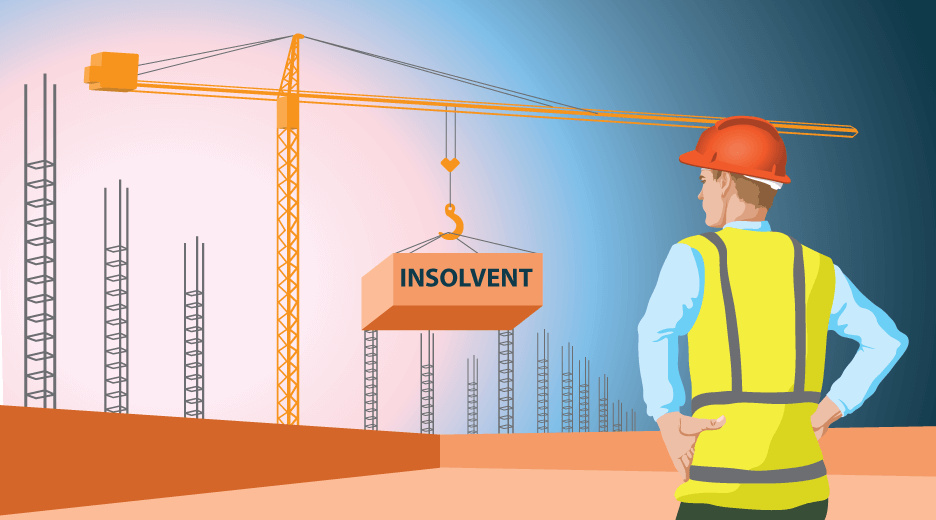When is a construction company insolvent?
How do we determine if a construction company is insolvent? Insolvency, as defined under Section 95A of the Corporations Act 2001 (Cth), occurs when a business or an individual is unable to meet their debts as they become due and payable.

In article:
Summary
- The construction industry in Australia has a high rate of company liquidations (about a quarter of all company liquidations);
- Liquidations in the construction industry have a substantial impact on industry participants themselves (developers, contractors and sub-contractors), as well as the broader economy;
- In determining solvency/insolvency in the construction industry, the focus is on cash flow and the current ratio;
- Distressed construction companies should consider the options that are available to them to both (a), prevent and (b), respond, to solvency challenges earlier rather than later.
The construction industry in Australia
The construction industry in Australia has its own peculiar challenges. Each significant project requires significant estimation, rather than precise calculation, before the project begins. This is why quantity surveyors and project managers are so integral to the industry. It also means that it is difficult for construction companies to size up jobs, and work out what their total costs will be.
This challenge is compounded by the prominence of sub-contracting in the industry. The client (often a property developer) enters into agreements with a contractor or contractors who have overall responsibility for the work on the project. That ‘head’ contractor then delegates work to sub-contractors who provide the ‘boots on the ground’. In the past, it has been estimated that up to 90 per cent of construction work is carried out by sub-contractors.
Construction is a competitive industry – this may mean that sub-contractors under-price their services in order to beat the competition. However, it is likely that the unpredictability of payment places ‘subbies’ in the toughest position. They are often signed up to a small number of large contracts which are carried out over an extended period of time. As ongoing payment is their source of cash flow, there is little buffer room if things go wrong. Furthermore, it’s often the case that they lack access to alternative sources of funding that may help them weather cashflow issues. Ultimately, the solvency of the subcontractor’s business is dependent on each large project being a success.
Compounding matters, the Australian property boom has propped up the construction industry for a long time. This means there has been a tendency for construction companies to assume that this will continue indefinitely and that payments will always be forthcoming. A housing slowdown (especially in New South Wales) would show this assumption to be unwise.
Consequences of the current operating model
The challenges faced by construction companies mean that insolvency and liquidation rates are high. In September 2019, it was reported that liquidation rates were the highest they had been since September 2015. In addition, a heavy reliance on sub-contractors means that the industry as a whole is vulnerable to a ‘domino’ effect. The insolvency of the ‘head’ contractor may mean that sub-contractors reliant on that income are forced into liquidation.
Further compounding the insolvency risks in the construction industry is the impact of unscrupulous ‘phoenix operators’. The Inquiry by the Senate Standing Committee on Economics (Senate Inquiry) examined the extent to which pre-insolvency advisors were recommending ‘phoenix activity’: An activity which, in its illegal form, means transferring assets for less than fair market value to another company before liquidation. Through this mechanism, it is alleged that some construction companies have been intentionally liquidating in order to avoid paying their debts. The Senate Inquiry looked in-depth into Walton Constructions (Qld) Pty Ltd (Walton’s), a company that collapsed in October 2013. In that case, the Senate Inquiry expressed concern over whether there had been professional advice which had facilitated phoenix activity. The Senate Inquiry ultimately concluded that hard-wired illegality is a deep feature of the construction industry.
There may be legal structuring options that mitigate insolvency risk. For example, some construction businesses have considered setting up a separate legal entity for each construction job. However, this is not always possible: It is often a requirement of a developer’s procurement process that contractors and sub-contractors have a history of solvency.
Determining insolvency in the construction industry
Putting aside the possible consequences of insolvency and liquidation. How do we determine if a construction company is insolvent? Insolvency, as defined under Section 95A of the Corporations Act 2001 (Cth), occurs when a business or an individual is unable to meet their debts as they become due and payable. As determined by the courts, there are two tests for insolvency:
- The cashflow test – this assesses the ability of a company to pay its debts (or sell its assets fast enough to pay its debts) as they become due and payable;
- The balance sheet test – this assesses the solvency of a company in reference to the total external liabilities against the total value of company assets. If liabilities exceed assets, the company is insolvent.
It is difficult to apply general standards of insolvency in the construction industry where it is the nature of the work that there is a significant lag between work completed and payment. Accrual accounting is misleading – cash flow is king. Consequently, the cash flow test is the most commonly used test in Australia and is the de facto test for building sub-contractors. Construction companies are banking on the prompt payment of each account and have few alternative sources of financing.
Employing the cashflow test, how do we determine whether a company is solvent or insolvent? It is a holistic judgement, but the most important financial ratio to be considered is the current ratio: comparing the companies short-term (current) assets with its short-term (current) liabilities. Relatedly, it is important to consider the Accounts Receivable Aging Schedule. If it is shown that accounts are being collected slower than usual or expected, this is a sign that cashflow problems are on the horizon.
The reality for subcontractors is that they are dependent on every job being a success. If one major job were to collapse they would still be on the hook for the employee and tax obligations flowing from their operations. A better indicator may be the quality of their developer clients and the integrity of their future payment arrangements.
External indicators of insolvency
The cashflow test is important for construction companies themselves to consider, but other parties won’t have access to that private financial information. As an independent third party, what indicators are there that building contractor might be having solvency issues?
In ASIC v Plymin & Ors (2003) 46 ASCR 126, Justice Mandy of the Supreme Court of Victoria referred to a checklist of 14 indicators of insolvency. In addition to liquidity issues, companies involved in the construction industry should ask whether there are any signs that the construction companies it is dealing with are experiencing the following problems:
- Continuing losses;
- Overdue Commonwealth and State taxes;
- Poor relationship with the present bank including inability to borrow additional funds;
- No access to alternative finance;
- Inability to raise further equity capital;
- Supplier placing the debtor on COD (Cash on Delivery) terms, otherwise demanding special payments before resuming supply;
- Creditors unpaid outside trading terms;
- Issuing of post-dated cheques;
- Dishonoured cheques;
- Special arrangements with selected creditors;
- Solicitors’ letter, summon(es), judgments or warrants issued against the company;
- Payments to creditors of rounded figures, which are irreconcilable to specific invoices;
- Inability to produce timely and accurate financial information to display the company’s trading performance and financial position, and make reliable forecasts.
Subcontracts have zero chance of obtaining any information from their developers that may give them prior warning of the above. The best pre-contract investigations they under could involve contacting the developer’s former subcontractors to check their prior dealings.
How should construction companies anticipate and deal with potential solvency issues?
While it is inevitable that some construction companies do end up being liquidated, the poor returns to creditors mean that this is an outcome to be avoided, if possible. A range of options that might be considered include:
- Alternative financing. Receivables Finance based on incoming payments could be used to bridge the gap between work and payment, but this can have high costs that soak up potential profits. While historically sub-contractors might have considered a mortgage facility on their own home, this has high risks and the latest generation of sub-contractors are less likely to have the necessary equity;
- Voluntary administration. This is a process where a troubled company appoints an independent professional to come to a ‘Deed of Company Arrangement’ (‘DOCA’) with creditors and, hopefully, save the business as a going concern. However, in Australia, the outcomes of this process are extremely poor for both the company itself (it usually ends up liquidated) and creditors (returns on a DOCA are usually paltry). For more information see What are the success rates of voluntary administration?
- Pre-insolvency advice and restructuring. Companies should consider whether ‘safe harbour’ provisions of the Corporations Act 2001 could be used to legitimately restructure a struggling business.
The most important step to take in order to avoid insolvency in the construction industry is preventative. Construction companies, and especially sub-contractors, need to consider how they can organise their business better from the beginning to avoid the identified pitfalls. This includes, for example:
- Investing in better accounting support – quicker information is best for identifying the correct response to cashflow problems while they can still be addressed;
- Engaging a counsellor if the directors or key staff have drug, alcohol or gambling problems or are suffering from a relationship breakdown;
- Optimal company structuring to best separate risk and ownership (for example, determining that a separate trust should hold the plant and equipment);
- More conservative growth ambitions to ensure that jobs aren’t under-priced or risky developers taken on;
- Manage by objectives and set Key Performance Indicators for all staff.

Additional reading:
The Complete Guide to Trading Trusts for small and medium-sized business
Key Takeaways
- The construction industry has a high rate of insolvency due to both the nature of the construction industry and the prevalence of sub-contracting;
- The test for insolvency in the construction industry is cash-based. Focus on the current ratio and aging of accounts receivable;
- Construction companies, especially sub-contractors, need to plan for cash pressures from the start. Once they do start to get in trouble, they need to seek professional advice as soon as possible to see whether restructuring options are available to them.